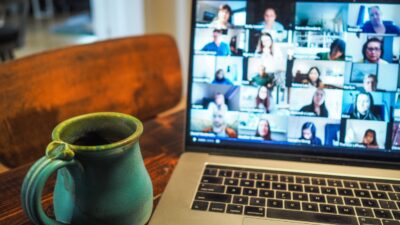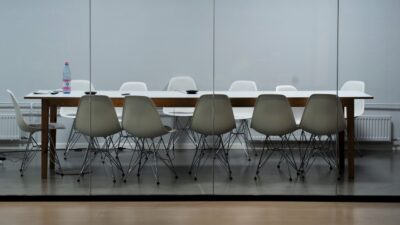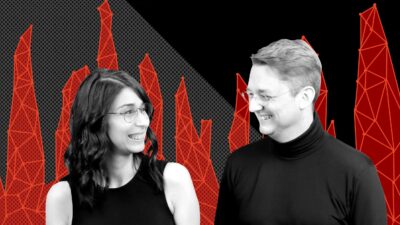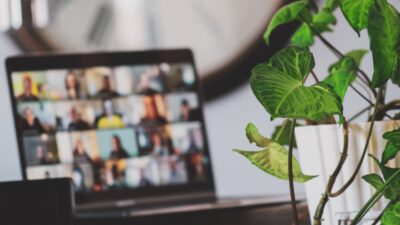Sandra Peter and Kai Riemer
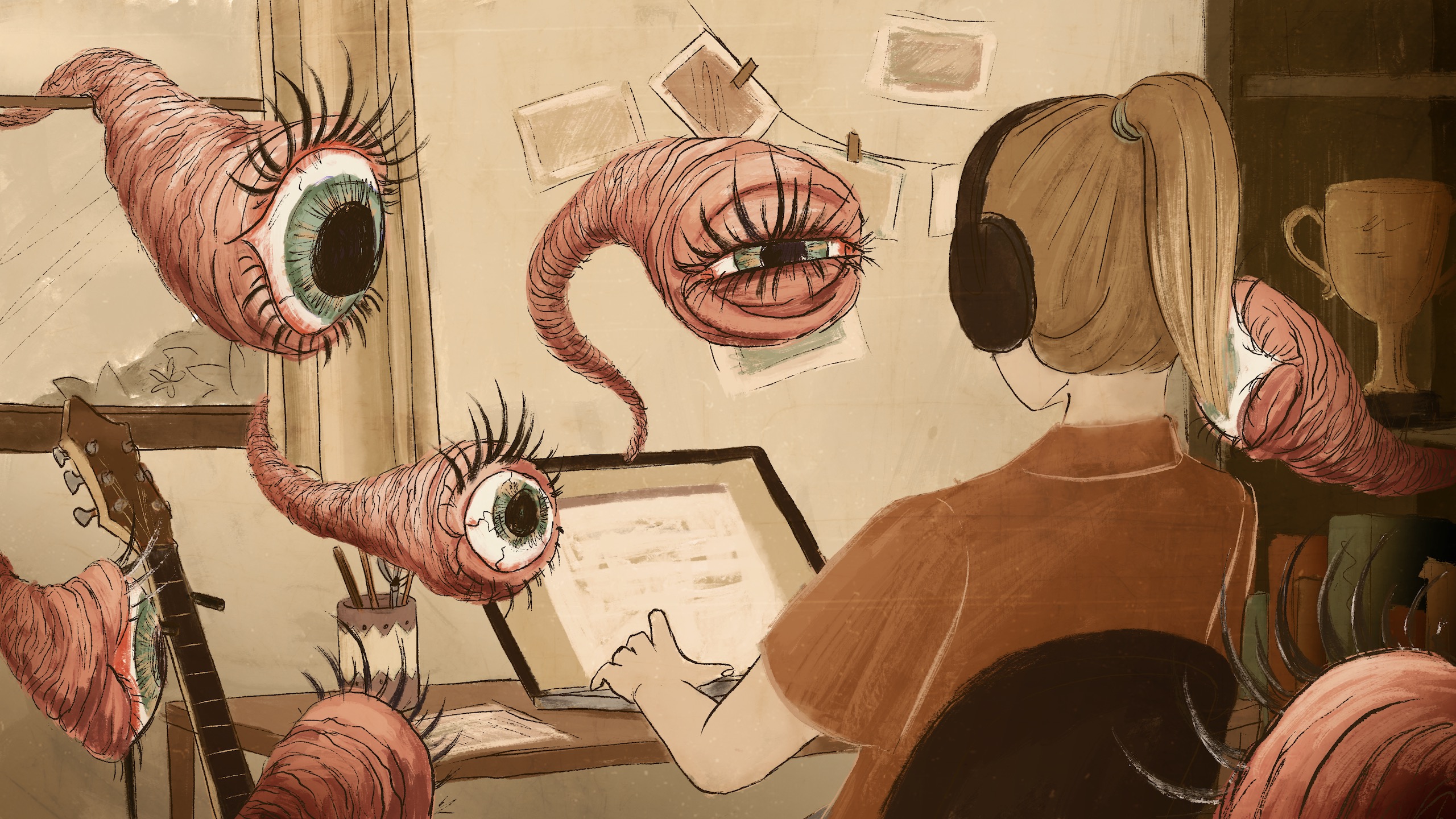
Corporate surveillance on Corona Business Insights
Corporate surveillance: heightened remote surveillance and activity tracking. This is part 2 of a 2-part special.
As COVID-19 sets out to change the world forever, join Sandra Peter and Kai Riemer as they think about what’s to come in the future of business.
Shownotes
This episode is part 2 of a 2-part special looking at monitoring and surveillance in the workplace. Listen to part 1.
2018 Gartner report on monitoring employee productivity
2019 Accenture survey on monitoring employee productivity
The workplace-surveillance technology boom
Your boss is watching you as you’re working from home
Employee monitoring in the NYT
HBR on how to monitor employees while respecting their privacy
Zoom disables attention tracking
PwC has developed an app that tracks how close employees get to each
Employee monitoring with daily activity points across applications
Capturing all keyboard activity for user-based behaviour analytics
Random screen captures for user-based behaviour analytics
Employee surveillance on the rise
Temperature checks in the workplace
Hospital monitoring tools for healthcare workers
Apps that ask employees to self-report their health symptoms
Our previous conversation on productivity and remote work on Corona Business Insights
Our previous conversation on the ideal worker on Corona Business Insights
Our previous conversation on contact tracing on The Future, This Week
This episode is part of a podcast series covering what COVID-19 will mean for the business world, where we look at the impact on the economy, businesses, industries, workers and society. This is part of our ongoing coverage of the impact of COVID-19 on the future of business.
Follow the show on Apple Podcasts, Spotify, Overcast, Google Podcasts, Pocket Casts or wherever you get your podcasts. You can follow Sydney Business Insights on Flipboard, LinkedIn, Twitter and WeChat to keep updated with our latest insights.
Send us your news ideas to sbi@sydney.edu.au.
Dr Sandra Peter is the Director of Sydney Executive Plus and Associate Professor at the University of Sydney Business School. Her research and practice focuses on engaging with the future in productive ways, and the impact of emerging technologies on business and society.
Kai Riemer is Professor of Information Technology and Organisation, and Director of Sydney Executive Plus at the University of Sydney Business School. Kai's research interest is in Disruptive Technologies, Enterprise Social Media, Virtual Work, Collaborative Technologies and the Philosophy of Technology.
Share
We believe in open and honest access to knowledge. We use a Creative Commons Attribution NoDerivatives licence for our articles and podcasts, so you can republish them for free, online or in print.
Transcript
This transcript is the product of an artificial intelligence - human collaboration. Any mistakes are the human's fault. (Just saying. Accurately yours, AI)
Intro From the University of Sydney Business School, this Sydney Business Insights.
Sandra And this is Corona Business Insights. I'm Sandra Peter.
Kai And I'm Kai Riemer.
Sandra And with everything that's happening out there, it's quite hard to understand what COVID-19 will mean for the business world. So in this series, we've been unpacking business economy in the street, government workers, our society and looking at the effects of the pandemic.
Kai This podcast is, of course, part of a larger initiative by the University of Sydney Business School. Our COVID business impact dashboard is a living initiative which we constantly update with insights and resources from academics, from industry experts, Nobel Prize winners, movers and shakers.
Sandra And you can find all of these resources online at sbi.sydney.edu.au/coronavirus.
Kai And today we talk about corporate surveillance in the age of COVID-19.
Sandra And this episode is the second one in a two-part special looking at what on the one hand has been called employee monitoring, and on the other hand, has often been referred to as corporate surveillance. We are looking at this topic from two different perspectives. On the one hand, the organisational managerial perspective. On the other one, the employee's point of view.
Kai And we would like to urge you to listen to both episodes, if you haven't listened to the other one please do it, because only then will you get a complete picture of how we see this topic.
Sandra So let's have a look now at corporate surveillance. All of us have at some point been concerned about surveillance, whether that is cameras strewn all across our cities or in the buildings where we work, or whether that was private technology companies monitoring our moves online and seeing every website we visit, everything that we purchase online and every conversation we have online. Not all of us have been as aware of what the organisations that we work for do in terms of monitoring our behaviour. Even though before COVID-19 many companies were already monitoring what we as employees do online. That is, over half the companies in a 2018 Gartner report, and over 60 percent in an Accenture survey last year, reported monitoring employee details or social media accounts or how we use our workspaces or how we interact with at work.
Kai Not all of us were experiencing corporate surveillance, but this has changed with the COVID-19 pandemic. There is now a real concern not only amongst employees, but also amongst the general population, that with technologies at the disposal of government and corporations, surveillance will increase both in the health space where technology such as contact tracing apps are now used to monitor the spread of the virus or indeed in the workspace where the recent move to working from home during the pandemic has now also led to a surge in the application of surveillance technology to monitor employee behaviour for productivity.
Sandra So those two categories of surveillance technologies, so the health ones, and the productivity ones, come into play at different points in the pandemic. Since many of us are still working from home. Let's first have a look at surveillance technologies used to monitor productivity.
Kai As many employees are now off-site, no longer within earshot of their manager. There's now a real push by organisations to keep tabs on what people are doing so that productivity doesn't slump, that people are not distracted and use the work time, the hours that belong to the organisation, so to speak, for actual work. And this can be done in different ways, either by monitoring the use of work-related apps, be this productivity apps or enterprise apps or communication technologies such as email clients, Slack, Teams and other technologies. Or with specialised solutions.
Sandra So whilst many of us were already aware that, for instance, the time we spend in our email applications is being monitored, how quickly we answer email. How much time we spend on various companies software platforms. In many cases, this has now given way to employees being tracked in everything that they do offline. That can go as far as, for instance, companies like Teramind capturing all keyboard activity and comprehensive logs, or servers that enable live video feeds off the camera you have on your laptop or on your home computer or random screen captures, or continuous screen captures so that everything you do, whether that is working on the presentation or watching a YouTube video or shopping online, can be recorded by the organisation you work for.
Kai And indeed, there have been quite a few articles in the past few weeks, and we're going to put those links in the shownotes in which people report firsthand about the intrusive nature of some of these technologies. So there's technologies that would randomly turn on the camera of the computer or take screenshots to keep a record of what people are working on, people who are on the clock, so to speak, who are paid by the hour. There is now software that monitors activity on the computer. And if someone steps away, say, to have a bathroom break, the software would come to the foreground and a counter would turn on. It would say things like, you have 60 seconds to resume work, otherwise your time will be stopped and then, you know, you're not getting paid for those minutes.
Sandra And sometimes these very intrusive measures are even embedded in applications that all of us have used during this lockdown. Many of us have used Zoom, the video conferencing software. Few of us were aware that Zoom has an option that allows for attention tracking. And whilst the feature had been implemented to make sure that the software can be used for training purposes, where it's really important that the company is aware that the person receiving the training is actually paying attention to that training and have not just turned the video on and left it to run. That feature now allows for hosts to see if meeting attendees go away from the app for any longer than 30 seconds during a meeting.
Kai And of course, after a widespread outcry, the company disabled this particular feature. But that doesn't mean that there isn't dedicated solution that go much, much further in tracking what people are doing and that can have quite severe privacy implications. You're in a private environment, you're at home. If the camera takes random shots of your surroundings to make sure the person is in front of a computer, who knows what might end up on those shots. Software solutions that take random screenshots of someone's screen might capture Zoom meetings that show the faces of clients, which are not only compromises the privacy of the employee, but the privacy of other people who are unaware of being filmed or photographed in this manner.
Sandra And indeed, let's remember that whilst in certain jurisdictions we have legislation that forces companies to disclose this, in the US, for instance, in many places organisations do not have to tell employees that they are being tracked.
Kai And of course, besides the intrusive nature, working in such a datafied environment under constant surveillance can feel quite stressful. People have reported, too, even feeling ashamed that they didn't work enough on a particular day. Once they saw these statistics on how much time they actually spend in the productivity app versus on social media or doing other things. So the question then arises, what is actually being achieved? What is actually being measured with these tools that track people's activity? And is this a good thing?
Sandra The problem stems from the fact that there are different types of work that people do online. If your job involves populating a spreadsheet or recording data or entering data, how much work you do or the amount of activity at the month of input that you have might be a really good measure of your productivity. For others, it might be a very poor measure. If you're just measuring how many emails are open or how many emails I write, you could gain very little insight into how productive I'm being.
Kai Yeah. So importantly, these tools often measure activity, but not output. So in essence, they measure input, and generating more input, being more busy, doing more work doesn't necessarily increase productivity if it leads to no increase in output. In fact, you know, doing more input for the same output is actually decreasing productivity. So we want to actually make sure that what is being measured is actually relevant to the work that is being achieved. The other aspect, of course, is that most often these tools measure quantity of work, but not quality of work. And putting people under stress, setting incentives to be more active, to do more busy work doesn't necessarily increase the output or the quality of work.
Sandra It's also important to be quite transparent about what is being measured and why and how that data is used. For many employees, there is a lot of uncertainty around how the monitoring will feed into their performance evaluations, into how they are being assessed at work, or what the consequences are of certain behaviours.
Kai And if those relationships are unclear, it might lead to quite perverse incentives to just engage in more of the activity that is being measured rather than doing the work that is actually beneficial to the outcome and to the organisation. But we also want to raise another aspect. It is often claimed that these technologies have managers to care more about their workers, to pay more attention to what workers are doing to foreground problems with people who might be struggling in their work and why that is true. It assumes that we have a caring supervisor at the other end. There's also a danger that work is being reduced to a metric, to a number, and that managers feel that they have work under control because they now have the data about what is going on, which might in turn lead to less checking in with the employee and two less human contact. So we really need to see those technologies within the environment and within the context on how management is being done.
Sandra And it is actually this responsible management that has brought in another whole set of corporate surveillance technologies as we continue to work during COVID-19 and as we return to the office. And these are the technologies that are being employed to monitor the health of people who have continued the work during the pandemic, such as warehouse workers or hospital workers. So introducing temperature cheques to make sure employees are healthy as they continue to work, or the range of technologies that are being implemented in and around the office space, as those of us who have been working from home returned to the office.
Kai And there's been reports that people are feeling really anxious. On the one hand, many people are sick and tired of being at home. They are craving to go out and go to the office, meet their colleagues and work in the proximity with others. But it is precisely that proximity that also creates anxiety, given that the pandemic in many jurisdictions around the world is not yet under control. So technologies can help with creating a safe environment that can help with social distancing. Monitoring technologies can help make sure that there's not too many people in certain parts of a building or in a meeting room. And contact tracing apps, for example, can help if there is indeed an outbreak to contain and make sure that people are being tested and isolated to kerb the spread within an organisation.
Sandra And while some of us are reassured by the fact that everyone's temperature is being checked as we arrive to work or that contact tracing is in place, there are also those measures that are invisible to employees. So, for instance, video streams from security cameras are now being used to monitor groups of people or gatherings of people, even when people are just socialising and not actually being in a meeting or conducting work related activities. And this, on the other hand, can feel quite intrusive.
Kai Let's not forget that while cameras exist in many office environments, they're largely invisible and people don't notice them anymore. Once this video feeds are used to, for example, enforce social distancing. In other words, when people become aware that they're being filmed and that this video stream is being acted upon, things can become weird. People might not want to gather in communal areas if this is at all possible. And so what is usually good about an office that people can meet? Other people have informal chats, engage in the sense making outside of the actual work task might actually be curbed by the use of surveillance technologies, in effect, achieving the opposite of what we want to achieve by bringing people back to the office.
Sandra And of course, there's also a temporal dimension to this. Whilst many of these surveillance technologies were introduced as a short-term measure to deal with the effects of the pandemic, many people are concerned that this will be around to stay in the long-term as the prolonged nature of the health crisis is helping normalise some of these technologies in the workplace.
Kai And this is where we want to leave it. We urge you to listen to the companion piece that looks at this story from the other perspective of employee monitoring.
Sandra This has been Corona Business Insights. Until next time.
Kai Thanks for listening.
Sandra Thanks for listening.
Outro From the University of Sydney Business School, this is Sydney Business Insights, the podcast that explores the future of business.
Close transcript

